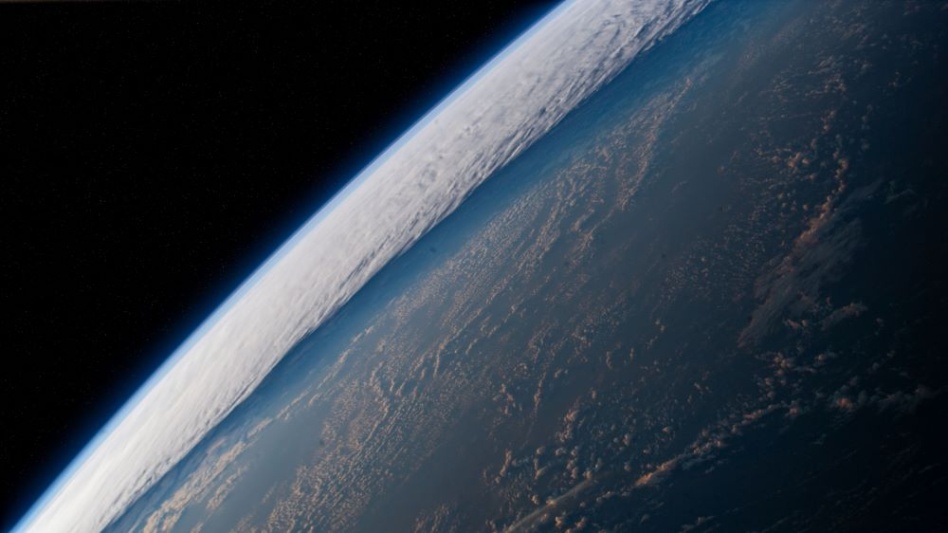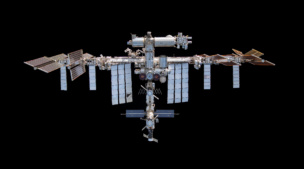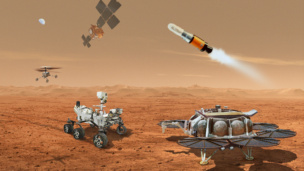Space technology benefits humanity every day, from scientific understanding to the nuts and bolts of supporting the systems that enable life as we know it, but some advocates worry regulators are not paying enough attention to the potential downsides of a bustling space economy.
With more launches going up and more satellites raining back down to Earth, one thing is clear: these space missions deposit toxic gasses and metals into our atmosphere. That fact, however, raises more questions than answers, including about what level of pollution makes a difference, what the dangers may be, and how the space industry should be regulated as spaceflight becomes more commonplace.
A lot of the impact of spacefaring still flies under the radar. The space industry, new and growing as it is, has never been held to strict environmental regulations for the justified fear that imposing stringent rules would stunt its growth—plus, the frequency of space launch has historically been low and assumed to have little effect on Earth’s environment.
That’s beginning to change. There’s a lot we still don’t know about the ways that space activities, including launch and reentry, affect the atmosphere and ultimately Earth’s climate. As we stand at the beginning of a new commercial space age, regulators are beginning to reconsider previously lax rules on spaceflight in order to preserve our fragile climate.
What goes up
For most of the history of spaceflight, launches and reentries were so few and far between that, compared to other industries, their impact was considered practically negligible. After all, what’s a rocket launch compared to emissions from the ~100,000 airplanes that take off every day around the globe?
“If we just look at how we have behaved in terms of exploration and things becoming common modes of transportation, we can see that we’re following that pattern for space,” Moriba Jah, space environmentalist and associate professor of aerospace engineering at UT Austin, told Payload. “We don’t have to repeat those sorts of things, but we are repeating those sorts of things.”
Everyone in the space community has heard (or said themselves) that the industry is at an inflection point, and a great boom—in technology, in the number of satellites launched, in market adoption across industries—is coming.
And it’s true, or at least, the beginning of that uptick has been crystal clear in the past few years. In 2022, there were 180 successful orbital launches globally, up from 133 the year before. In the coming years, that number is expected to skyrocket. Starship, if all goes according to Elon Musk’s plan, could launch 100T to orbit as often as three times per day within a handful of years, and though that projection feels a bit like science fiction, the fact is that both the demand for and capability to send hundreds of rockets to orbit each year is imminent.
Gaps in understanding
So an important question remains: is this actually impacting Earth?
The short answer is…probably. It’s difficult to quantify on the way up, because the precise impact of a rocket launch on Earth’s atmosphere is spread across every part of the atmosphere, and on the way down, because so little research has been done on the effects of satellite vaporization upon reentry.
Rocket launch: The effect of rocket launches in the upper levels of the atmosphere—particularly their tendency to release chlorine directly into the ozone layer—has long concerned both scientists and regulators.
It’s hard to dispute that serious pollutants are emitted into the atmosphere with every rocket launch.
- SpaceX’s Falcon 9, the most frequently-launched rocket in the world today, uses rocket-grade kerosene as fuel, which releases black carbon—a known major contributing factor to climate change causing negative health effects in humans—upon combustion.
- The Soyuz line of rockets also uses kerosene.
- Many solid rocket fuels, including those used by the Ariane 5, release alumina into the atmosphere, another hazardous particle known to contribute to climate change.
- Other fuels used for rocket launches, including liquid hydrogen and liquid methane, burn more cleanly—but it’s worth noting that even water emissions can have significant effects when ejected from a rocket directly into the stratosphere.
Reentry: Rocket launches aren’t the only part of the space technology life cycle with a potential impact on Earth’s environment and atmosphere. Each year, hundreds of metric tons of material reenters Earth’s atmosphere from space when satellites that have outlived their usefulness are deorbited, and it’s still not totally clear how the particles created as satellites burn up in the atmosphere might affect our climate.
Ten years ago, Government Accountability Office (GAO) data showed that ~200T of satellites reentered the atmosphere per year. Now, tracking with an increase in commercial launch and greater utilization of LEO, that number is more like ~800T per year, according to Martin Ross, a scientist studying commercial launch impacts at The Aerospace Corporation.
“The future decadal trend is to approximately 16,000 tons reentering each year (mostly satellites),” Ross told Payload via email. “The bottom line is that reentries have grown by about a factor of four in the past decade and—if the many plans for large low earth orbit constellations come to pass—reentries will grow at an even faster pace of about [a factor of] 20 in the next decade.”
Rules and regulations
When it comes to the space industry’s legal obligations to protect Earth’s environment, limits on activities are relatively scarce and, where they exist, pretty vague and difficult to enforce.
There are a lot of reasons for that. The commercial space industry is still new, and it’s growing very rapidly, with the number of satellites reaching orbit increasing year after year. Atmospheric emissions are notoriously hard to measure, and there hasn’t been enough time or research to fully understand what’s being emitted into the atmosphere upon launch and reentry. Regulators aren’t in the business, generally speaking, of making rules about activities that haven’t been definitively proven to have a negative impact, particularly when such regulation could squash a nascent commercial sector.
The responsibility for regulating the space industry’s environmental impact in the US is spread out across a number of different regulatory agencies.
Down to NEPA: The environmental impact of lanches is regulated under the National Environmental Policy Act (NEPA), which requires all government agencies to consider the environmental impact of the activities they allow. For the space industry, the power to allow spaceport construction and issue launch licenses falls to the FAA, meaning that it’s the FAA’s responsibility to conduct NEPA reviews for rocket launches and satellite reentry.
“Every FAA-issued commercial space license undergoes a NEPA-compliant environmental review,” an FAA spokesperson confirmed to Payload in an emailed statement. “Every commercial space launch and reentry is covered either by the environmental review of the underlying FAA-issued license or by a new environmental review as warranted.”
Right now, NEPA is in a fluctuating state—Trump-era rollbacks gave the act less bite, altering the rule implemented in 1970 to narrow the scope of what constituted a “major federal action” that could impact the environment (meaning fewer projects would require review at all), and to stop requiring assessments of the indirect or cumulative impacts of the rule.
The Biden administration has made efforts to restore certain parts of NEPA, including requiring agencies to once again consider the direct, indirect, and cumulative impacts of the activities they license. Though the cumulative impact portion was restored in 2022, it’s very difficult to estimate the cumulative impact of multiple rocket launches, and harder to draw a line at a number of launches at which point the environmental impact is harmful.
“Apart from the targeted changes to the 2020 Rule, the 2022 Rule leaves in place a number of changes from the 2020 Rule,” according to a report from law group K&L Gates. “These include, for example: requiring environmental impact statements to be completed within two years and environmental assessments within one year; aggregating categorical exclusions for use across multiple agencies; considering comments only if they are ‘exhaustive’; and excluding smaller projects from NEPA review.”
The 2024 election poses further uncertainty—a second Trump term might mean another flip of the regulations, and other Republican candidates are also running on easing the impact of environmental and climate regulation to stimulate business.
NEPA also does not always apply. While major projects with likely significant impacts to the environment are required to submit an environmental impact statement—as in the case of Starship’s test flights—other actions require little to no environmental review. The act includes a categorical exclusion, which allows agencies to opt out of performing reviews for activities they deem low-impact. The FCC, which currently holds the responsibility for licensing satellite constellations (and therefore for performing their NEPA reviews), has recently come under fire for its lax interpretation of the categorical exclusion, allowing projects from 5G tower installations to megaconstellations to receive licenses without environmental consideration.
Atmospheric emissions: The FAA is responsible for licensing launch activity and reentry, but when it comes to regulation and protection of the Earth’s atmosphere itself, the Environmental Protection Agency (EPA) is in charge. The EPA regulates sources of greenhouse gas (GHG) emissions and distinguishes between mobile and stationary sources of emissions.
- Stationary sources, such as mining operations or power plants, don’t move.
- Mobile sources, such as airplanes and rockets, do.
- Only stationary sources that emit over a set level of air emissions are required to apply for Title V permits to continue operations.
But when EPA is looking to set standards, goals, and regulations for the atmospheric impacts of spaceflight, they need the baseline data to set that up—and that’s no easy feat.
“It’s incredibly complicated to measure and baseline carbon, where it is, where it’s going, where it came from, and how all of these natural systems interact with carbon in the Earth system,” Daniel Barrie, a program manager in the NOAA climate program office, told Payload.
NASA and NOAA also play a role in developing policy and standards for space activities, particularly when it comes to emissions and environmental impacts. Barrie described that role as “policy-relevant but not policy-prescriptive.”
Essentially, that means that these agencies, geared mainly toward scientific exploration and research, will provide the information and guidance needed for other agencies to take action by developing more stringent policies.
“There’s a lot of connection with agencies that have a big footprint in adaptive action, like Army Corps, FEMA for emergency preparedness and planning, and other agencies as well,” Barrie said. “For mitigation, there’s collaboration with EPA, which does set policy on greenhouse gasses and standards. And some of the newer work is critical to that process in providing baselines using remote sensing.”
Though the managers at NOAA and NASA who oversee climate impact research and conduct the field studies that expand the understanding of how certain human activities, including spaceflight, are impacting Earth’s climate, their role isn’t to make policy recommendations. Instead, the data they collect is used to inform decisions made in whatever silo is doing the regulating.
“There’s this vast amount of work at NOAA that covers the carbon system, the biogeochemistry on the land surface and the atmosphere in the oceans as well,” Barrie said. “And that information is critical, ultimately, to policy planning and policy decisions, but we’re not making those decisions. We’re not suggesting the decisions that should be made. We’re just trying to provide the best information.”
The end in sight
Advocacy groups, government agencies, and larger-scale organizations (hello, UN) have been working for decades to figure out how to slow the impacts that we humans are having on the global climate. To date, space activities have mostly stayed under the radar of environmental concern, but as that changes and regulators start to fret over the impacts of emissions in the stratosphere, they’re looking to the aviation industry as a guide.
The space industry is not regulated like the airline industry; however, if rockets begin lifting off multiple-times-a-day as predicted, the airline industry is likely the best corollary we have. That’s not to say, however, that the world has done a great job of reining in aviation emissions—one of the UN’s 17 sustainable development goals to achieve by 2030 looks specifically at rectifying the adverse impacts of air travel on the environment.
The EPA has the power to regulate emissions from rocket launches under the Clean Air Act, but it does not. It does exercise its authority to regulate aviation emissions, but it’s a fairly new development, with standards passed in 2020 and a rule enforced in 2021.
“Under Title VI of the Clean Air Act, EPA may consider establishing standards and requirements regarding rocket launches in order to prevent ozone depletion, especially as impacts may affect the United States’ progress in keeping its international promises in the Montreal Protocol,” according to the Georgetown Environmental Law Review.
The standards passed in 2020 were the first strict emissions limits passed on aviation, as mature as the industry is. Those standards require airlines to use greener fuel and make climate-friendly improvements to their aircraft by 2028—but the EPA doesn’t expect the rule to actually lower emissions, just keep them from rising and worsening.
Even if the EPA chose to impose similar regulations on spaceflight right now, it would be nearly impossible to actually back up those regulations with implementation. Launchers don’t have the option to just switch out the fuel used in their rockets, so requiring a blanket switch to a greener alternative wouldn’t make sense (though rockets that do use greener fuels off the bat are already in development). It’s also hard due to the many, many unknowns of how rocket launch and reentry impacts the atmosphere today. The next step—as was the first step in aviation—is setting a reliable baseline.
Is it enough?
The wide consensus among regulators and the space industry is that it is still too early in the story of commercial spaceflight to impose stringent regulations and rules on launch and reentry because their impact on the environment is, to date, not big enough to make a major difference. Basically, the government has bigger fish to fry when it comes to remaining compliant with environmental targets like the Montreal Protocol and the UN’s sustainable development goals.
The goal, according to Jah, ought to be “trying to make decisions that don’t outpace the environment’s feedback on letting you know whether or not the consequences, especially the unintended consequences, are ones that you can live with.”
If the polluting effects of the aviation industry and other heavy industrial industries are any guide, it doesn’t do well to wait until the damage is done before implementing rules on emissions and environmental impact.
“While currently the impact of rocket launches is seemingly negligible compared to that of other industries, with the rise of space tourism and the continued privatization of space, it may be time for environmental regulators to turn their attention to the new space race,” wrote the Georgetown Law Review.
The ethos that it is too early for space activities to make a difference in our Earth’s climate is based on two major assumptions. The first is related to a lack of knowledge and research about how much space activities are actually polluting, and relies on ignorance about the amount of black carbon, alumina, and other pollutants both on the ground and throughout the stratosphere. When it comes to reentry, the impact on the upper levels of Earth’s atmosphere is even less understood.
The second assumption fails to plan effectively for the future. Though space activities may be just a drop in the bucket now (and that’s debatable), the cadence of launch is only expected to increase at an accelerating rate over the coming decade, and the lack of restrictions on these activities could lead to detrimental effects sneaking up on the industry and planet before we know it.
But progress is being made in increments. On Nov. 29, the Biden administration released a national greenhouse gas emissions monitoring strategy, which will pull in data from across federal agencies to build a better understanding of emissions sources and mitigation strategies.
“I think it’s in government’s best interest to say, ‘Hey, if I want if I want to keep on using orbital space and I want companies from my country to enjoy making lots of money from space, then I need to make sure that that environment is one that is one that is sustainable, so that they can thrive,’” Jah said.




